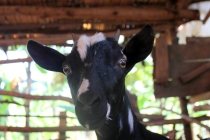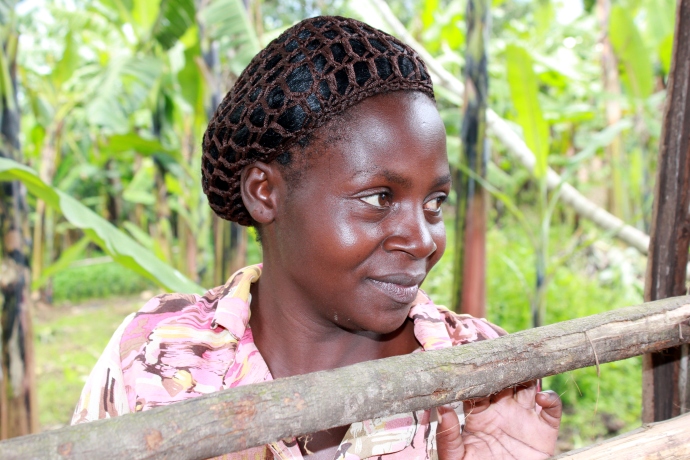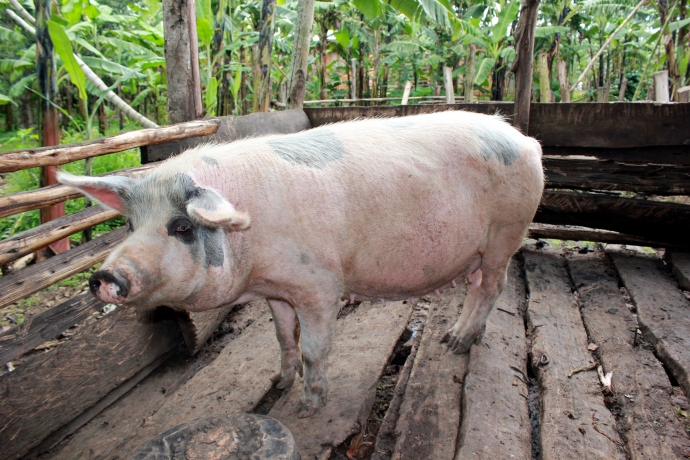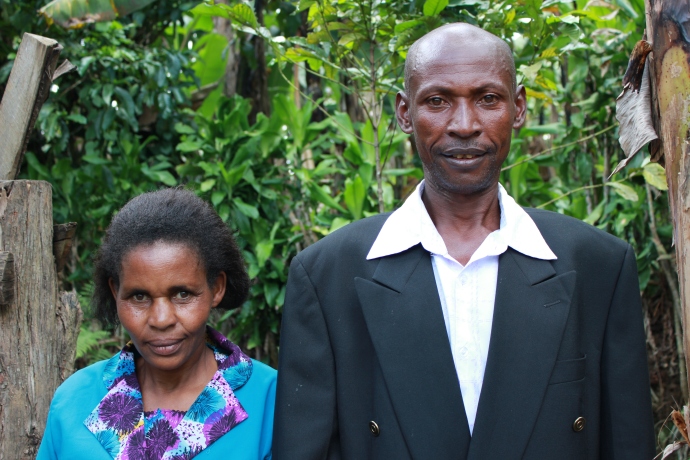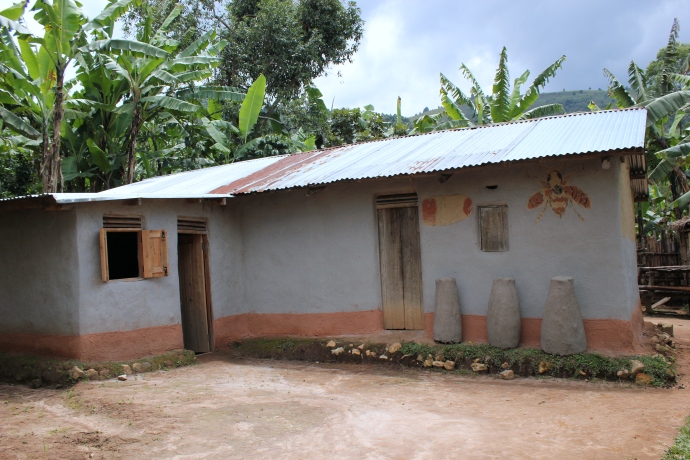 Because I can’t WAIT to get started on this blog, even though my first official trip isn’t until January 22, when I leave for Guatemala, I’m writing this post from my Heifer Trial Run in Uganda, in November 2011 — which was spectacular!!)
Because I can’t WAIT to get started on this blog, even though my first official trip isn’t until January 22, when I leave for Guatemala, I’m writing this post from my Heifer Trial Run in Uganda, in November 2011 — which was spectacular!!)
When I first was driven up to the Kinkizi Piggery Heifer International project in Rukungiri, Uganda, I expected to be met by a family or two. Instead, we pulled into a block party – 30 or so people, dressed to the nines, were singing dancing, drumming and clapping to welcome me. Whoa.
“Who do they think I am, Hillary Clinton without the pantsuit?” I wondered guiltily.
I sat attentively with George Asilmwe, the extension coordinator for Heifer Uganda, while the women launched into another song, “We are happy to meet you, welcome …” and I was delighted to hear the singers stretch “wel-eh-come” into a three-syllable word. The choir director was as exuberant as Leonard Bernstein, and I croakily sang along. Then we got down to business as I munched on my elaborately-served refreshments of bananas, peanuts and soda pop (a rare treat in the countryside).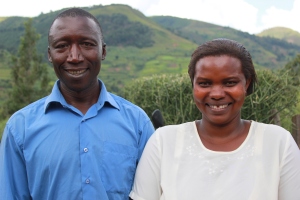
The chairperson, members of the executive committee and zone leaders (all elected from the community, by the community) greeted me and thanked me for coming. They lauded the benefits they had gained from this Heifer project, which started in 2007 and includes 50 families (it’s now been “weaned” as they say in Heifer language). Then they asked me to speak – which was not something George had prepared me for. But gamely, I talked about my joy in being there and my desire to hear the families’ stories and to share them with my readers. (I didn’t mention a blog since I figured they would think it was some kind of water problem or rodent).

A clean pig is a happy pig!
Then off we went on the home visits. Everyone walks everywhere in Uganda, so as we walked (with 35 people clustered around me and children peeking shyly up at me from behind their mothers’ skirts), I asked the kind of stupid questions only a Westerner would. Were pigs better than cows? (Yes, for a small household. And sows are better than cows because they won’t mate again once they’re pregnant …good to know!) Why do you build a shed? (They used to tether their pigs but the Heifer trainings taught them to build a shed instead – so the pigs won’t root around and destroy their banana plantations and they can be kept clean, healthy and unsmelly.) Keeping the pigs in a shed also allows the farmers to collect the manure easily, and use it to fertilize crops, like coffee, corn and beans that can be planted under the banana trees and earn the families added income. In fact, the manure is almost as valuable as the animal itself.

Sam's son on the family's flourishing banana plantation -- thanks, manure!!
Before an animal is ever given away, Heifer trainings also encourage the families to build pit latrines, create a nearby “safe station” for hand-washing, and build a utensil rack to keep pots and pans off the ground. This radically cuts down on disease and germs.

Hands-free washing station - so clever!
Extension leaders also teach every household to build an energy cooking stove out of clay, that will use half as much wood (which also means half the hauling, chopping and deforestation), and cook faster as well. And then there are plentiful lessons in animal husbandry, teaching people when the pigs are ready to breed (at 3 months) the gestation period (3 months, 3 weeks and 3 days–now that’s precision birthing!), and when they can be separated from their mother and sold (1 ½ months). I was taking notes as fast as my chubby hands could write – but it wasn’t until we went to the second house that the transformative impact that Heifer has had on these families really sunk in.
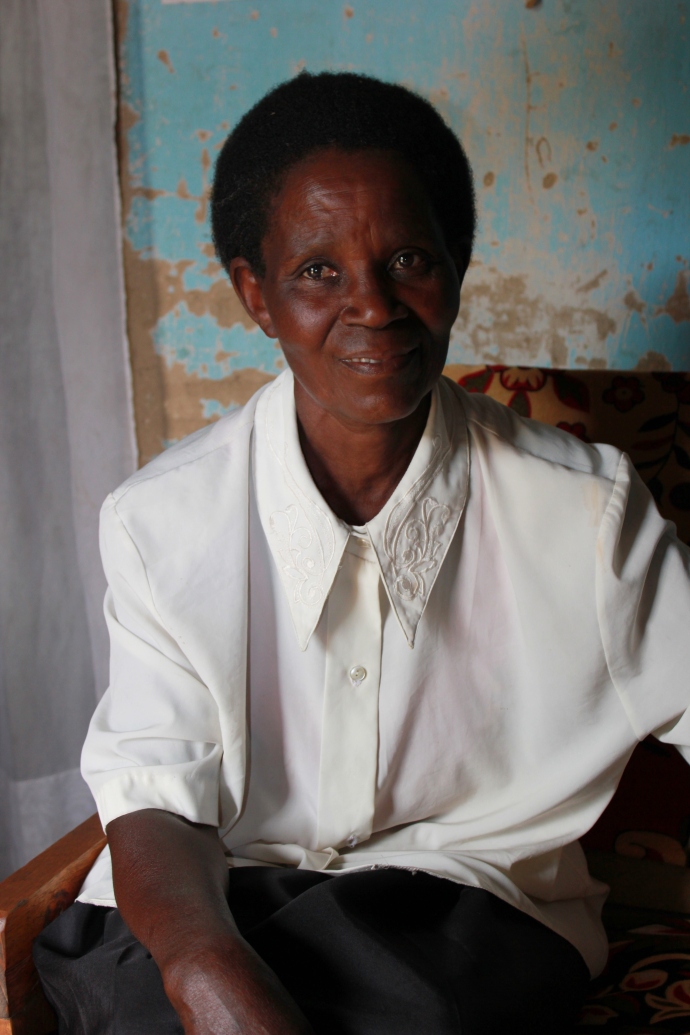 Ruth Kamugisha is a widow. A few years ago, she received one sow from a family who was Passing on the Gift and that pig had 11 piglets (one of whom she Passed Along to another poor family), then her pig had 12 more piglets, then 14 more piglets. With that abundance, Ruth was off and running. She sold most of the piglets, and using that money, she was able to pay the school fees for her children, the oldest of whom is now a teacher. Because of what she learned of animal husbandry from the Heifer training, Ruth was able to cross-breed her stock, and raise her animals in a healthy way – without them smelling or fouling her house. “I am very happy to have a clean home,” she says, and I look around to see that her house is plain but spotless indeed.
Ruth Kamugisha is a widow. A few years ago, she received one sow from a family who was Passing on the Gift and that pig had 11 piglets (one of whom she Passed Along to another poor family), then her pig had 12 more piglets, then 14 more piglets. With that abundance, Ruth was off and running. She sold most of the piglets, and using that money, she was able to pay the school fees for her children, the oldest of whom is now a teacher. Because of what she learned of animal husbandry from the Heifer training, Ruth was able to cross-breed her stock, and raise her animals in a healthy way – without them smelling or fouling her house. “I am very happy to have a clean home,” she says, and I look around to see that her house is plain but spotless indeed.
““Heifer redeemed us from poverty,” Ruth says, sitting ramrod straight in an immaculate white blouse and neat black skirt. “Because of Heifer’s gift, I have money to buy mattresses for my children to sleep on, and blankets to keep them warm. That was a dream for me,” Ruth says. “I bought these chairs, too,” she says proudly of the plain wooden seats beneath us, “and I am saving up to buy cushions.”
I can’t help thinking of Lulu’s pre-college trip to Bed Bath & Beyond where we dropped $200 in an hour on containers to hold the tons of stuff that we were lugging up to NYC … and contrasting that to Ruth’s painstaking labor to save enough shillings to buy a $3 cushion for her chair, in her tiny house with its new roof of tight iron sheets, that she also proudly bought with the money from her Heifer pigs.
“I am full of praises for Heifer,” she says with a big smile that fades into sorrow as she explains, “I lost my husband and that keeps me alone. But my other two daughters are finishing school,” she perks up, thinking of the future, “and the secret has been the piglet I was given by Heifer.”
As we walk to the next house, I want to give Ruth a hug – so I do. Of all the women dancing when our car pulled up, Ruth was the most extravagant, joyful dancer – whirling and turning and stomping her feet. She has a hard life but she is strong, capable and accomplished…and thanks to Heifer, she has hope for the future. 
I’m full of her praises, too.
 I don’t know jack about raising animals – and I don’t think I’m alone. In fact, it can be said (and yes, dozens of people have said, in various terms of disparagement) that I am not an animal person at all.
I don’t know jack about raising animals – and I don’t think I’m alone. In fact, it can be said (and yes, dozens of people have said, in various terms of disparagement) that I am not an animal person at all.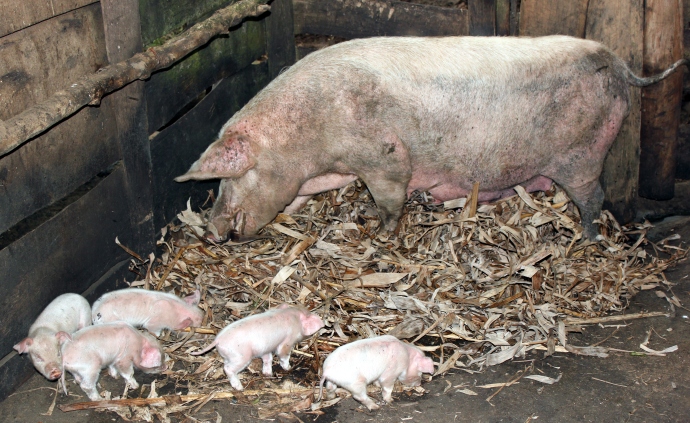 In Uganda, pigs are valued for their meat, their manure, and their ability to produce other pigs – and lots of them. The mommy pig is a sow; the daddy pig is a boar – and piglets can become parents at an astonishing six months of age. Pretty much as soon as they’re weaned, they’re ready to roll. The gestation period for a pig is apparently as precise as a Rolex –and their litters are huge: a sow will often produce 10-15 piglets in one furrow. And they’ll produce at least five farrows in a lifetime. That’s some serious fertility.
In Uganda, pigs are valued for their meat, their manure, and their ability to produce other pigs – and lots of them. The mommy pig is a sow; the daddy pig is a boar – and piglets can become parents at an astonishing six months of age. Pretty much as soon as they’re weaned, they’re ready to roll. The gestation period for a pig is apparently as precise as a Rolex –and their litters are huge: a sow will often produce 10-15 piglets in one furrow. And they’ll produce at least five farrows in a lifetime. That’s some serious fertility.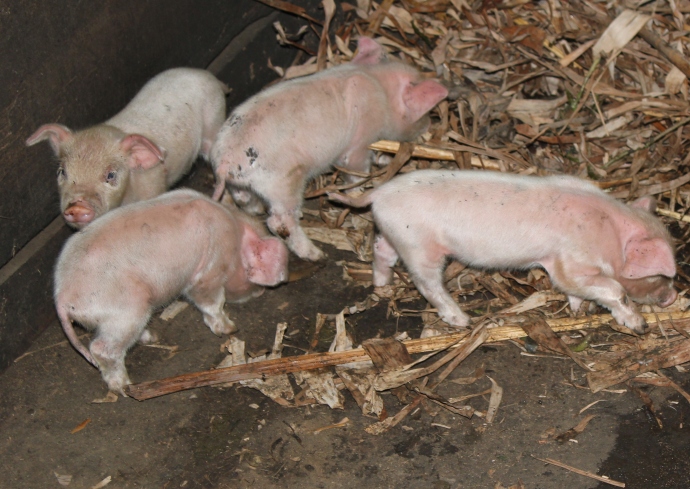 Almost as precious as piglets is pig poop …which can be used to fertilize banana plants, maize, coffee, potatoes, cassava, and all kinds of fruit trees. When you’re raising everything you eat, and there are no stores in the event you run out of Hot Pockets, a better crop isn’t just a luxury, it’s a lifeline. And poop makes a huge difference.
Almost as precious as piglets is pig poop …which can be used to fertilize banana plants, maize, coffee, potatoes, cassava, and all kinds of fruit trees. When you’re raising everything you eat, and there are no stores in the event you run out of Hot Pockets, a better crop isn’t just a luxury, it’s a lifeline. And poop makes a huge difference.
